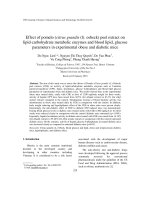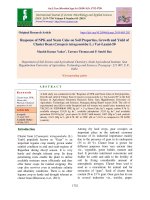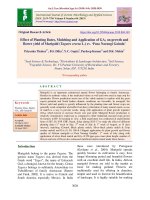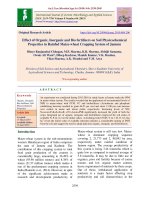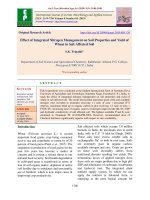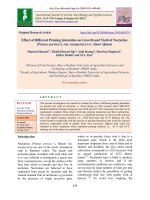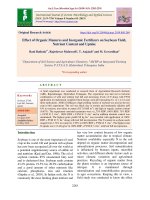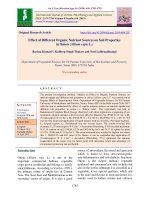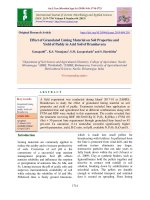Effect of different levels of organic and inorganic fertilizers on soil properties, growth and yield of radish (Raphanus sativus L.) var. Pusa Chetki
Bạn đang xem bản rút gọn của tài liệu. Xem và tải ngay bản đầy đủ của tài liệu tại đây (190.37 KB, 6 trang )
Int.J.Curr.Microbiol.App.Sci (2020) 9(8): 2291-2296
International Journal of Current Microbiology and Applied Sciences
ISSN: 2319-7706 Volume 9 Number 8 (2020)
Journal homepage:
Original Research Article
/>
Effect of Different Levels of Organic and
Inorganic Fertilizers on Soil Properties, Growth and
Yield of Radish (Raphanus sativus L.) var. Pusa Chetki
Varna Sindhu*, Narendra Swaroop, Tarence Thomas and Smriti Rao
Department of Soil Science and Agricultural Chemistry, Naini Institute of Agriculture,
Sam Higginbottom University of Agriculture Technology and Sciences,
Prayagraj, 211007 (UP) India
*Corresponding author
ABSTRACT
Keywords
Soil properties,
Nitrogen,
Phosphorus,
Potassium, FYM,
Vermicompost,
Neem cake
Article Info
Accepted:
20 July 2020
Available Online:
10 August 2020
The present investigation entitled “Effect of different levels of organic and inorganic
fertilizers on soil properties, growth and yield of Radish (Raphanus sativus L.) var. Pusa
chetki”. Field experiment was conducted at Department of Soil Science and Agricultural
Chemistry, Naini Agricultural Institute, Prayagraj – 211007, during rabi 2019 – 2020. The
experiment consists of 9 treatments including recommended dose of inorganic fertilizers,
FYM, vermicompost, neem cake in different combinations and absolute control. The
experiment was laid out in a Randomized Block Design with three replications. The results
showed that progressive increase in the level of N P K and organic manures used from
different sources in the experiment, the treatment combination (25%NPK + 25% VC +
25% FYM + 25%NC) significantly increased the physical and chemical analysis
parameters i.e. Bulk density (Mg/m3), Particle density (Mg/m3), Pore space (%), Water
retaining capacity (%), Specific gravity, Soil Ph (1:2) w/v, Soil EC (d S/m), Organic
carbon (%), Available Nitrogen (Kg/ha), Available Phosphorus (Kg/ha), Available
Potassium (Kg/ha) of soil.
Introduction
Radish (Raphanus sativus L.) belongs to the
family Brassicaceae and it has 2n=18
chromosomes. It is a popular root vegetable in
both tropical and temperate regions. It can be
cultivated under cover for early production
but larger scale production in field is more
common in Haryana, West Bengal, Punjab,
Bihar, Assam, Madhya Pradesh and other
some state of India. In Madhya Pradesh,
radish is grown in 10440 ha with a production
of 153270 tonnes (Anonymous, 2016-17).
Radish is grown for its young tender tuberous
root which is consumed either cooked or raw.
It is a good source of vitamin-c and minerals
like calcium, potassium and phosphorus. It
has refreshing and diuretic properties. It is
also used for neurological headache,
sleeplessness and chronic diarrhoea. The roots
are also useful in urinary complaints and
piles. The leaves of radish are good source for
extraction of protein on a commercial scale
and radish seeds are potential source of non-
2291
Int.J.Curr.Microbiol.App.Sci (2020) 9(8): 2291-2296
drying fatty oil suitable for soap making
illuminating and edible purposes. Availability
of nitrogen is important for growing plants as
it is a major indispensable constituent of
protein and nucleic acid. The primary goal of
integrated nutrient management is to combine
old and new methods of nutrient management
into ecologically sound and economically
viable farming systems that utilize available
organic and inorganic sources of nutrients in a
judicious and efficient way.
Radish being a short duration and quick
growing crop, the root growth should be rapid
and uninterrupted. organic, inorganic and
biofertilizers are essential (Dhanajaya, 2007).
Further, due to higher cost of nitrogenous
fertilizers and its ill effect on soil health and
water, it is becoming imperative to go for
alternative and cheaper sources like organic
manures (Kumar et al., 2014).
Materials and Methods
The field experiment was conducted to study
the effect of different levels of organic and
inorganic fertilizers on soil properties, growth
and yield of Radish. The field experiment was
carried out during the Rabi season 2019 2020 at the research farm of Department of
Soil Science and Agricultural Chemistry,
Naini
Agriculture
Institute,
Sam
Higginbottom University of Agriculture,
Technology and Sciences (U.P.) located at
25ᵒ.27’ N latitude 81ᵒ.57’ E longitude and
98m above mean sea level. Soil samples were
taken from 0-15cm depth of soil randomly
prior to tillage operations, air dried and
passed through 2 mm sieve. Then the
composite sample was taken for mechanical
and
chemical
analysis.
Bouyoucos
hydrometer method (1957) was used for the
mechanical analysis of soil to determine sand,
silt and clay percentage in the sample.
Chemical analysis of the soil showed a neutral
pH (7.14), 0.41 dS/m EC, 0.8% Organic
carbon, 254.6 kg/ha Nitrogen, 18.3 kg/ha
Phosphorus, and 103.2 kg/ha exchangeable
Potassium. Recommended dose of N, P and K
(100:80:50 kg N, P2O5 and K2O/ ha) were
applied. Full dose of P and K were applied
along with 50 per cent of N at the time of
planting. The remaining 50 per cent N was
applied at time of earthling up. Agro
climatically, Prayagraj district represents the
subtropical belt of the South East of Uttar
Pradesh, and is endowed with extremely hot
summer and fairly cold winter.
The maximum temperature of the location
ranges between 46 ᵒC - 48 ᵒC and seldom falls
below 4 ᵒC - 5 ᵒC. The relative humidity
ranges between 20-94%. The average rainfall
of this area is around 1100mm annually. The
experiment was carried out in RBD
(Randomised Block Design) with three
replications for each treatment.
The inorganic source of fertilizers was
satisfied with Urea, MOP (Muriate of Potash),
DAP (Di-ammonium Phosphate) (as N, P, K)
and organic source as Farm Yard Manure
(FYM), Vermicompost (VC), Neem cake
(NC) which had a significant effect on the
growth and yield of Radish. The treatment
combination was laid out as, T1-control, T2100% NPK, T3-100%VC, T4-100%FYM, T5100%NC, T6-50%NPK + 50%VC, T750%NPK + 50%FYM, T8-50%NPK +
50%NC, T9-25%NPK + 25%VC + 25%FYM
+ 25%NC respectively.
Results and Discussion
The initial and final values of physical
properties and chemical properties are given
below (Table 1–3).
Bulk density (Mg/m3)
The effect of different levels of NPK and
(FYM, VC & NC) showed significant on bulk
2292
Int.J.Curr.Microbiol.App.Sci (2020) 9(8): 2291-2296
density in soil after harvest of radish. The
maximum bulk density was recorded highest
at T0 (Control) with value 1.23 and the lowest
value 1.11 was recorded at T9 (25% NPK +
25% VC + 25% FYM + 25% NC). As
compared to pre-harvest soil bulk density of
1.30, the bulk density of post-harvest soil
decreases.
reported byKumar et al., (2008), Reddy et al.,
(2005) and Ghulam et al., (2016).
Pore space (%)
Decrease in BD might be due to higher
accumulation of organic carbon and
improvement in soil structure. Similar results
were also reported by Moharana et al.,
(2017), Rudrappa et al., (2006), Kumar et al.,
(2008), Reddy et al., (2005).
The effect of different levels of NPK and
(FYM, VC & NC) showed significant on %
pore space in soil after harvest of radish. The
maximum % pore space of soil was recorded
63.22% in treatment T9 (25% NPK + 25%VC
+ 25% FYM + 25% NC) and minimum %
pore space of soil was recorded 42.3% in
treatment T0 (control). Similar results were
also reported by Kumar et al., (2008), Reddy
et al., (2005) and Ghulam et al., (2016).
Particle density (Mg/m3)
Water retaining capacity (%)
The effect of different levels of NPK and
(FYM, VC & NC) showed significant on
particle density in soil after harvest of radish.
The maximum Particle density (gcm-3) of soil
was recorded 2.79 Mg m-3 in treatment T9
(25% NPK + 25% VC + 25% FYM + 25%
NC) and minimum Particle density (Mg m-3)
of soil was recorded 2.22 Mg m-3 in treatment
T0 (control). Similar results were also
The effect of different levels of NPK and
(FYM, VC & NC) showed significant on
water retaining capacity (%) in soil after
harvest of radish. The maximum water
retaining capacity of soil was recorded
67.73% in treatment T9 (25%NPK + 25%VC
+ 25%FYM + 25%NC) and minimum water
retaining capacity of soil was recorded
53.98% in treatment T0 (control).
Table.1 Analysis of soil before sowing
Parameters
Sand (%)
Silt (%)
Clay (%)
Texture of soil
Bulk density (Mg/m3)
Particle density (Mg/m3)
Pore space (%)
Water retaining capacity (%)
Specific gravity
Soil colour
pH
EC (dS/m)
OC (%)
Available Nitrogen (kg/ha)
Available Phosphorus (kg/ha)
Available Potassium (kg/ha)
2293
Results
70.10
17.20
12.70
Sandy loam
1.26
2.55
54.6
62.36
2.33
Light yellowish brown
7.14
0.41
0.8
254.6
18.3
103.2
Int.J.Curr.Microbiol.App.Sci (2020) 9(8): 2291-2296
Table.2 Effect of different levels of organic and inorganic fertilizers on physical properties of
soil after harvest of Radish
Treatments
T1
T2
T3
T4
T5
T6
T7
T8
T9
F- test
S.Ed. (±)
C.D. at 0.5
Bulk density
(Mg/m3)
1.23
1.11
1.15
1.14
1.14
1.21
1.21
1.19
1.11
S
0.010
0.038
Particle density
(Mg/m3)
2.22
2.34
2.41
2.48
2.40
2.75
2.73
2.65
2.79
S
0.017
0.062
Pore
space (%)
42.23
45.73
51.43
52.46
52.33
62.74
61.46
59.2
63.22
S
0.836
3.003
Water retaining
capacity (%)
53.98
59.10
64.23
63.51
62.36
66.38
65.75
66.33
67.73
S
0.477
1.716
Specific
gravity
2.10
2.26
2.26
2.34
2.33
2.44
2.44
2.38
2.48
S
0.012
0.044
Table.3 Effect of different levels of organic and inorganic fertilizers on chemical properties of
soil after harvest of Radish
Treatments
pH (1:2) w/v
EC
(dS/m)
OC (%)
T1
T2
T3
T4
T5
T6
T7
T8
T9
F- test
S.Ed. (±)
C.D. at 0.5
7.3
7.25
7.22
7.07
7.17
7.06
7.12
7.11
7.03
S
0.014
0.050
0.21
0.33
0.43
0.43
0.42
0.56
0.56
0.53
0.61
S
0.012
0.044
0.32
0.65
0.77
0.77
0.75
1.10
1.06
1.12
1.15
S
0.052
0.186
Available
Nitrogen
(kg/ha)
239.15
259.54
259.38
274.28
269.07
285.80
281.59
284.35
287.46
S
1.635
5.874
Available
Phosphorus
(kg/ha)
15.93
18.16
19.68
18.08
19.81
20.92
19.81
21.87
22.76
S
0.640
2.299
Available
Potassium (kg/ha)
116.53
122.1
134.24
134.99
135.62
169.82
169.90
165.90
174.85
S
1.428
5.129
minimum specific gravity of soil was recorded
as 2.10 in treatment T0 (control).
Specific gravity
The effect of different levels of NPK and
(FYM, VC & NC) showed significant on
specific gravity (g cm-3) in soil after harvest of
radish. The maximum specific gravity of soil
was recorded 2.48 in treatment T9 (25% NPK +
25% VC + 25% FYM + 25% NC) and
Soil pH
The pH of soil increased significantly &
progressively with the increasing levels of N, P,
K and with the levels of inorganics (FYM,
2294
Int.J.Curr.Microbiol.App.Sci (2020) 9(8): 2291-2296
Vermicompost & Neem cake) were found to be
significant. The highest pH (7.30) was recorded
with treatment T1 (Control) followed by
treatmentT2 (100% NPK), (7.25); whereas the
lowest value was observed with treatment
combination T9 (25% NPK + 25%VC + 25%
FYM + 25% NC) (7.03). The decrease in soil
pH may be due to formation of bicarbonate and
ammonium nitrate by the application of urea
that reacts with H+ ions which caused reduction
in acidity. Similar findings were reported by
Roshan et al., (2014) and by Ojha et al., (2009)
status Ajebesone et al., (2011). The increase in
available N may be due to application of VC,
FYM and NC which is the major source of
nitrogen and the soil physic-chemical
characteristics are very much benefited by VC,
FYM and NC. The increased in available N
have also been reported by Ojha et al., (2009)
and Ghulam et al., (2016).
Available Phosphorus (kg/ha)
The EC of soil increased significantly &
progressively with the increasing levels of N, P, K
and with the levels of inorganics (FYM,
Vermicompost & Neem cake) were found to be
significant. The highest EC (0.61) was recorded
with treatmentT9 (25% NPK + 25%VC + 25%
FYM + 25% NC) followed by treatmentT6 (50%
NPK + 50% VC), (0.56); whereas the lowest
value was observed in treatment T1 control (0.21).
Roshan et al., (2014), Ojha et al., (2009) and
Takase et al., (2011).
The maximum available phosphorus of soil was
recorded 22.76 kg/ha in treatment T9 (25% NPK
+ 25% VC + 25% FYM + 25% NC) and
minimum available phosphorus of soil was
recorded as 15.93 kg/ha in treatment T0
(control). Das et al., (1991) reported that
application of FYM, VC and NC resulted in
tremendous increase in available P status of soil
which might be attributed to the build-up of
available P owing to the formation of fulvic
acid and other chelating agents which form
soluble complexes with native P in soils. The
increased in available P have also been reported
by Ojha et al., (2009) and Ghulam et al.,
(2016).
Organic carbon (%)
Available Potassium (kg/ha)
The maximum organic carbon of soil was
recorded 1.15% in treatment T9 (25%NPK +
25%VC + 25%FYM + 25%NC) and minimum
organic carbon of soil was recorded as 0.32% in
treatment T0 (control). Similar findings have
also been reported by Moharana et al., (2017),
Rudrappa et al., (2006), Ghulam et al., (2016)
and Kumar et al., (2008)
The maximum available potassium of soil was
recorded 174.85 kg/ha in treatment T9
(25%NPK + 25%VC + 25%FYM + 25%NC)
and minimum available potassium of soil was
recorded as 116.53 kg/ha in treatment T0
(control). The increase in available K may be
due to higher application of NPK along with
FYM, VC and NC which is advantageous as
improved soil physical properties, also due to
availability of more nutrients as compared to
their individual effects reported by Ojha et al.,
(2009) and Ghulam et al., (2016).
Soil EC (ds/m)
Available Nitrogen (kg/ha)
The maximum available nitrogen of soil was
recorded 287.46 kg/ha in treatment T9
(25%NPK + 25%VC + 25%FYM + 25%NC)
and minimum available nitrogen of soil was
recorded as 239.15 kg/ha in treatment T0
(control).
The application of organic or inorganic
fertilizers is widely known to ameliorate soil N
On the basis of the results obtained in the
present investigation, it might be concluded that
application of 25%NPK + 25%VC + 25%FYM
+ 25%NC (T9) followed by 50%NPK + 50%VC
(T6) shown significant effects on soil, growth
and yield of Radish.
2295
Int.J.Curr.Microbiol.App.Sci (2020) 9(8): 2291-2296
References
Anonymous 2016-17. www.nhb.gov.in
Bouyoucos GJ. 1951. A recalibration of the
hydrometer method for mechanical
analysis of soil. Agron. J, 43:434-438.
Dhananjaya, J. 2007. Organic Studies in Radish
(Raphanus sativus L.) Varieties,
(Department of Horticulture College of
Agriculture, Dharwad University of
Agriculture Science, Dharwad – 580
005, Pg.12-13.
Ghulam Mohammad, Arun David A. 2016.
Impact of integrated nutrients on soil
fertility status under potato cultivation
(Solanum tuberosum L.). International
Journal of Multidisciplinary Research
and Development. 3 (5): 149-152.
Kumar S, Maji S, Kumar S, Singh HD. 2014.
Efficacy of organic manures on growth
and yield of radish (Raphanus sativus
L.) cv. Japanese White. Int. J Plant Sci.
9 (1):57-60.
Kumar, J., 2008 Physio-chemical properties of
the soil, under the two - forest
plantation stands around Varanasi
(U.P.), India.
Moharana PC, Sharma BM, Biswas DR. 2017.
Changes in the soil properties and
availability of micronutrients after six year application of organic and
chemical fertilizers using STCR-based
targeted yield equations under pearl
millet wheat cropping system. Journal
of Plant Nutrition. 40:2:165-176
Ojha R, Mandal E, Pareta D, Thomas T.2009.
Effects of Combined Application of
Inorganic and Azotobacter on Chemical
Properties and N, P, K Availability after
Potato Harvest. Environment and
Ecology. 27 (4B):1899-1902.
Reddy, K. C. and Reddy, K. M. 2005.
Differential levels of vermicompost and
nitrogen on growth and yield in onion
(Allium cepa L.) – radish (Raphanus
sativus L.) cropping system. J. Res.,
Angrau. 33 (1): 11-17.
Roshan Babu Ojha, Shree Chandra Shah,
Keshab Raj Pande, Durga Datta Dhakal.
2014. Residual Effect of Farm Yard
Manure on Soil Properties in Spring
Season, Chitwan, Nepal. International
Journal of Scientific Research in
Agricultural Sciences. 1 (8):165-171.
Rudrappa L, Purakay Astha TJ, Dhyan Singh,
Bhadraray, S. 2006. Long-term
manuring and fertilization effects on
soil organic carbon pools in a Typic
Haplustept of semi-arid sub-tropical
India. Soil and Tillage Research.
88:180–192.
S. R. Olsen, C. V. Cole, F. S. Watanabe and
Dean, “Estimation of Available
Phosphorus in Soils by Extraction with
Sodium Bicarbonate,” USDA Circular
No. 939, U.S. Government Printing
Office, Washington DC, 1954.
Subbaih, B.V. and Asija, C.L. 1956. A rapid
procedure for the estimation of
available nitrogen in soils. Current sci.
25: 256-260.
Takase, M., Sam-Amoah, Owusu, L. K. and
Sekyere, J. D. 2011. The Effects of
Four Sources of Irrigation Water on
Soil Chemical and Physical Properties.
Asian Journal of Plant Sciences. 10 (1):
92-96.
Walkley A, and I. A. Black, 1934. An
Examination of Degtja-reff Method for
Determining Soil Organic Matter and a
Proposed Modification of the Chromic
Acid Titration Method, Soil Science. 37
(1): 29-38.
How to cite this article:
Varna Sindhu, Narendra Swaroop, Tarence Thomas and Smriti Rao. 2020. Effect of Different
Levels of Organic and Inorganic Fertilizers on Soil Properties, Growth and Yield of Radish
(Raphanus sativus L.) var. Pusa Chetki. Int.J.Curr.Microbiol.App.Sci. 9 (08): 2291-2296.
doi: />
2296
